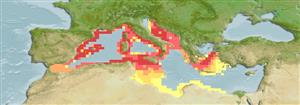Common names from other countries
Elasmobranchii (tubarões e raias) (sharks and rays) >
Rajiformes (Skates and rays) >
Rajidae (Skates)
Etymology: Raja: Latin, raja, -ae = a sting ray (Raja sp.) (Ref. 45335).
Issue
The few specimens examined of this species are most probably teratologic individuals of Leucoraja fullonica. A doubtful species until genetic/molecular clues are provided and published (B. Séret, pers.comm. 03/09) (Ref. 78469:14).
Environment: milieu / climate zone / depth range / distribution range
Ecologia
marinhas demersal. Subtropical
Northeast Atlantic: known only from the French Mediterranean coast and Gulf of Genoa in Italy.
Tamanho / Peso / Idade
Maturity: Lm ? range ? - ? cm
Max length : 50.0 cm TL macho/indeterminado; (Ref. 3167)
Oviparous (Ref. 50449). Eggs have horn-like projections on the shell (Ref. 205).
Ciclo de vida ou comportamento de acasalamento
Maturidade | Reprodução | Desova | Ovos | Fecundidade | Larvas
Oviparous, paired eggs are laid. Embryos feed solely on yolk (Ref. 50449).
Stehmann, M. and D.L. Bürkel, 1984. Rajidae. p. 163-196. In P.J.P. Whitehead, M.-L. Bauchot, J.-C. Hureau, J. Nielsen and E. Tortonese (eds.) Fishes of the north-eastern Atlantic and Mediterranean. UNESCO, Paris. vol. 1. (Ref. 3167)
Status na Lista Vermelha da UICN (Ref. 130435)
CITES (Ref. 128078)
Not Evaluated
Ameaça para os humanos
Harmless
Uso pelos humanos
Mais informação
Idade/Tamanho
Crescimento
Peso-comprimento
Comprimento-comprimento
Frequências de comprimento
Morfometria
Morfologia
Larvas
Dinâmica larval
Recrutamento
Abundância
ReferênciasAquaculturaPerfil para aquaculturaEstirpesGenéticaElectrophoresesHereditariedadeDoençasProcessamentoConversão de massa
Ferramentas
Relatórios especiais
Baixar XML
Fontes da internet
Estimates based on models
Preferred temperature (Ref.
115969): 13.1 - 15.2, mean 13.9 (based on 64 cells).
Índice de diversidade filogenética (Ref.
82804): PD
50 = 0.5000 [Uniqueness, from 0.5 = low to 2.0 = high].
Bayesian length-weight: a=0.00269 (0.00124 - 0.00582), b=3.26 (3.09 - 3.43), in cm Total Length, based on LWR estimates for this Genus-body shape (Ref.
93245).
Nível Trófico (Ref.
69278): 3.5 ±0.44 se; based on food items.
Resiliência (Ref.
120179): Baixo, tempo mínimo de duplicação da população 4,5 - 14 anos (Fec assumed to be <100).
Fishing Vulnerability (Ref.
59153): Moderate vulnerability (40 of 100).
